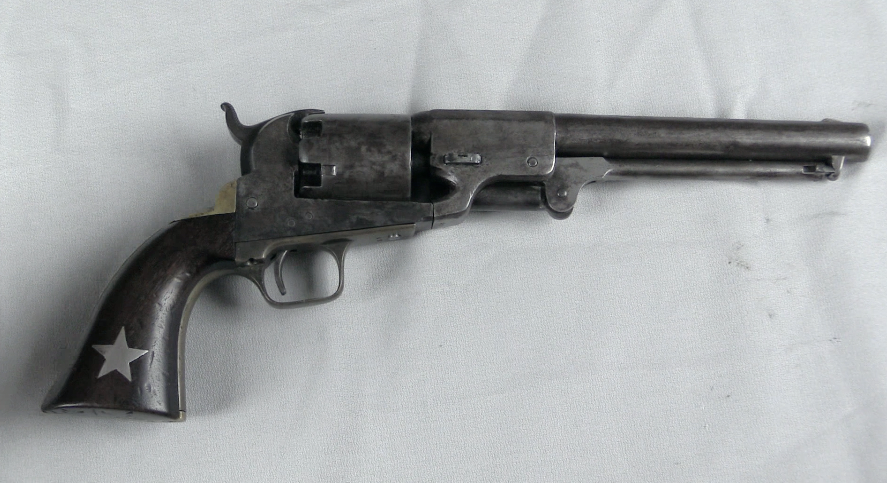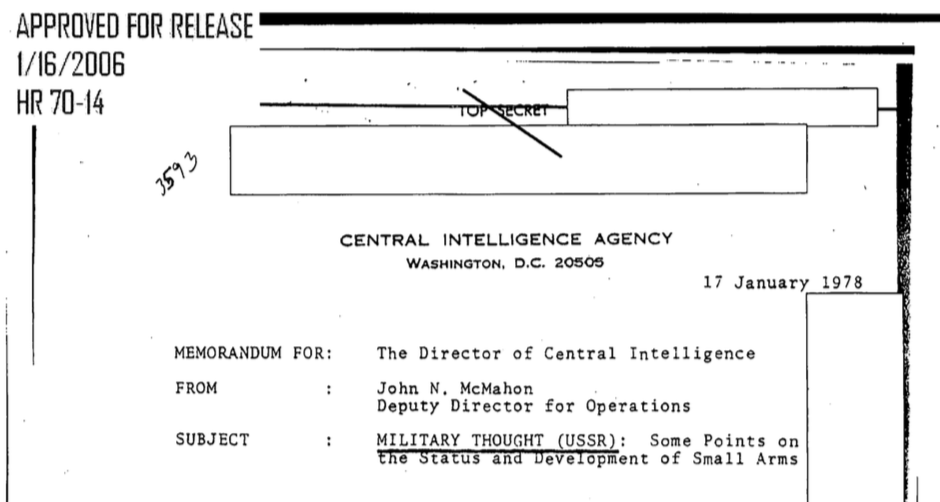Thanks to Legacy Collectibles, today we have a unique Colt prototype pistol to look at today – a double-action variation of the 1911. Judging by the grips and markings, this was made in the late 1950s – but I have been unable to find any documented record giving details. The double action capability was added by dropping the trigger mechanism down a bit, extending the trigger, and adding a linkage between lugs added to the side of the trigger and hammer. The original single action sear mechanism and trigger bar were left intact, and the added mechanism is simply a cocking lever – firing is done by the original elements.
In addition to the D/A linkage, another safety mechanism has been added to the slide. What looks like a decocting lever is actually a simple firing pin retractor. When engaged, it pulls the firing pin forward such that the hammer does not strike it when dropped. This effectively safes the gun. Presumably, this would have been a replacement for one of the other safeties already present on the design (grip and thumb), as it seems rather redundant when added to those others.
Make sure to check out Legacy Collectibles’ YouTube channel! They have a bunch of videos on interesting firearms and firearms collecting:
https://www.youtube.com/channel/UCesjdfSFVwNgqa299Bf3Zlw




The grip looks like a “pinky hanger”. It would also increase the muzzle flip with the bore so high above the hand. I can see why it didn’t make to production.
This is one of those attempts to outmatch a double-action pistol by modifying an existing design just so the manufacturer wouldn’t have to invest in new tooling. With this in mind, Colt wanted to make the best effort while spending very little money in the process. And here, they saved pennies but cost themselves hundreds of dollars…
Springfield Armory tried to outmatch the AK rifles by “converting” the design of the M1 Garand into the (eventual) disappointment we all know as the M14. Result: You can’t turn a rifle designed for perfect shot-placement into a “do everything weapon,” no matter what you try. Oh, and mass-issuing the M14 to the entire US Army and the Marine Corps took SEVEN FREAKING YEARS because of the long wait for new production tooling anyway. I could be wrong.
M-14 design has made a comeback in more recent years so it was not such a disappointment design-wise. Rather it was the case of the powers that be did not realize the future of real assault-style weapons pioneered by the Germans and then the Soviets in the AK-47. So the military tried another Battle Rifle design.
The M14 (T44) was not developed in response to the AK. They followed very different development tracks, the T44 as a reserve option if the preferred T25 failed as an all-purpose weapon intended to replace the SMG, M1 carbine, rifle (M1 Garand), and BAR.
Not a bad idea as shown by the FN LAC or even the EM2, but impossible using the T65 (later 7.62 NATO) cartridge.
The FG42 had shown that the idea was very nearly possible, but at 11lbs weight (not the 7 (!) sought by the US Army), and with design features including a straight-line stock, high sights, and a muzzle compensator that gave huge blast and flash. Also see: early AR10.
The AK was originally conceived as a sort of long-range SMG to supplement the SKS as the general service rifle, because the Russians hadn’t quite understood the Sturmgewehr idea, despite being shot with them a lot in 1943-45.
Judged by 1940 standards, the M14 was excellent. By 1960 standards, it was poor.
If you look on Seecamp.com you may find your answer. Larry scamp was in on the project. I saw a pistol on his work desk. When I was there.This goes back to when I lived in R.I. It was acceptable for me. Not suppose to be visiting. But you never know till you try. Sorry that I no. longer possess my Seecamp .32acp pistol.
Hope this helps.
This particular firearm didn’t influence 1911 much, however, in the 1980’s the quest for DA/SA double stack 9mms was in full swing and there were makers who added those features to the 1911. At the time a number of gunwriters extolled the advanced features adopted, yet the S&W 4506 was already on the market and in LEO holsters. I believe that may have been the bigger influence.
Of course, subsequent to that, polymer imports became available and the cost of injection molding a frame with pennies of fiberglass reinforced nylon was substantially less. A machined alloy frame become second best in competitive bidding and a lot of departments didn’t like having to train up in trigger options compared to the revolvers they were leaving behind. So, Glock dominated and became common.
Innovation comes around and goes around, it’s now SIG leading the charge with a drop out trigger control unit which allows customization of the pistol grip by simply changing it out, unlike conventional frames with a permanently attached serial number. We are at the early stages of another turnover in pistol design yet quite a few American shooters even recognize it. Fire Control Unit design will eventually dominate whether we are ready to accept it or not. What may become more interesting is when a hammer fired option arrives on the market and you not only get your choice of optional DA, SA, or both, but you can kit it with the grip length and slide length you prefer, all out of the same box.
Wake up, Murica, this is an exciting time to be involved in new guns!
Sig’s P250 DAO says hi. The market didn’t go for it.
Classic post WW2 Colt semi-auto pistol (Commander and variants excepted). That is, bad.
By Rampant Colt, out of CZ38. Quick! Shoot it! What an awful design!
Puts the Double Eagle in a while new light – and makes Ludwig Seecamp look like a flippin’ genius.
The handle has a “pinky drift hunters hanger” appearance. Having the muzzle bore thus much above the shooter’s hand would further enhance muzzle flip. I can understand why they decided not to put it into production.
The design is practically the same as Seecamp.
I think this is one of his first attempts at conversion, he made thousands of them.
Or (if looking at a custom grip), indeed, it was Colt who tried to “invent” Seecamp.
It looks like Colt had already lost its way a lot earlier than I thought
The serial number area of the frame is slightly dished, it looks like that frame may have had a different number at some time during its life. Possibly in the factory?
I guess that back in the late 50s, when the police were mostly carrying revolvers, and were accustomed to revolvers,
The higher bore line in order to get double action, might not have seemed so egregious
The firing pin retractor looks like a negligent discharge just waiting to happen.
I can understand a de cocker
But having to first use a safety, then pull the trigger to drop the hammer after you have racked the slide…
That’s just asking for someone to forget the safety then pull the trigger.
There are enough stories of embarrassing holes in walls, floors, ceilings etc in cop shops, made with revolvers. This thing looks even more likely to make them.
Final thought
Is there a shortened sliding trigger behind the new pivoting trigger?
“…sliding trigger behind the new pivoting trigger…”(С)
Yes. 4.30
To be fair, the bore axis doesn’t seem higher than in the S&W Model 39 and 59.
Yup,
Revolver ad the paradigm
Except, why go for a 7 shot, but more finicky auto, over a 6 shot, totally reliable revolver?
It’s a forgotten weapon right from the start.
Colt had already lost their way.